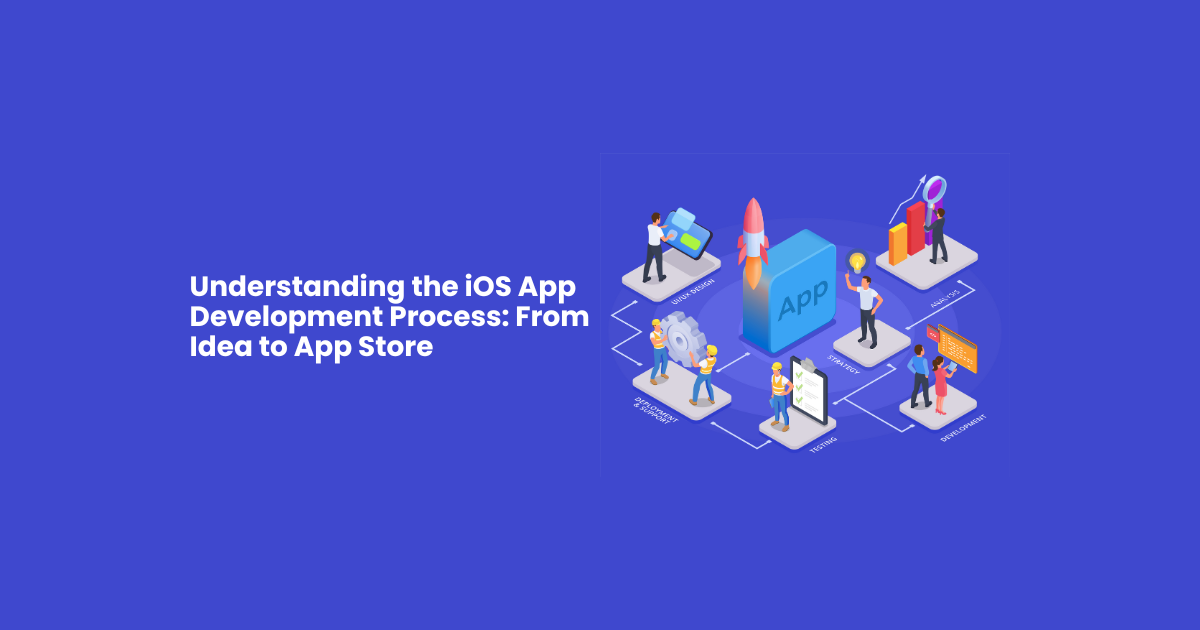Understanding the iOS App Development Process: From Idea to App Store
With over 2 million apps available on the Apple App Store, iOS app development process continues to dominate the mobile app development market, offering lucrative opportunities to businesses looking to venture into this thriving industry or create a digital presence.
Looking to create a mobile app but not sure where to launch your first-ever app in 2025?
However, creating a successful iOS application is not just about having a million-dollar app idea. To make your app successful, you need to have the right app development strategy in mind. It requires a proper, structured development process, right from ideation to App Store submission.
Here in this blog, we will share a complete iOS app development lifecycle to help you understand what it takes to turn your idea into a fully functional app and make it survive on the millions of devices.
Step 1: Conducting In-Depth Market Research
Developing your first-ever iOS app can be an exciting process, but soon that excitement will turn into a blunder if you are trying to proceed without conducting market research. Every successful app starts with a clear, well-defined idea, and asking yourself these questions will be a worthy decision:
- What problem is my app addressing?
- Who is my target audience?
- What features are essential to solve the problem effectively?
Once the concept is clear, conduct thorough market research. For this, understand the offerings of your competitors, analyze user reviews, and look for gaps you can fill with your app.
Step 2: Smart Planning with Valid Strategy
After validating your idea, the next step is defining your app’s roadmap, which includes
- Choosing the right platform, whether it will be native iOS or cross-platform.
- Deciding on monetization models, whether they be in-app purchases, ads, or subscription models.
- Outlining core features and functionalities of the app to avoid blowing your budget.
- Allocate the phases of your iOS app development process and set valid timelines.
This is the stage where you also need to decide whether to hire an iOS app development company or to hire a freelancer for your project. Your ultimate decision to hire the resources can make a huge difference in the project quality and delivery timelines.
Step 3: Emphasising on UI/UX Design
When it comes to developing an app for the App Store, keep in mind that Apple emphasizes on clean, intuitive, and user-focused designs. So, to avoid app rejection at the last, pay attention to designing user-friendly UI/UX designs that enhance user engagement. For this, designers should work on
- Wireframes: Visual blueprints of screen layouts
- Prototypes: Interactive versions to simulate user interactions
- UI design: Using Apple’s Human Interface Guidelines (HIG) to ensure your app feels native
- Remember, users expect seamless navigation, minimal clutter, and visually appealing elements.
Step 4: Finally coding the iOS Development
The App Store follows rigid regulations for iOS app deployment, so to avoid having coding bugs, it is worth hiring iOS app developers who have experience in Objective-C and Swift programming languages. Apart, pay attention to both components:
Frontend: Developed using Swift or Objective-C via Xcode, Apple’s official IDE.
Backend: Includes server-side logic, database management, and APIs. Developers may use Node.js, Python, Firebase, or other solutions.
This stage follows either Agile or Waterfall methodologies, with sprints and iterations for flexibility and fast feedback.
Step 5: Test Your App For Bugs and Performance
Before releasing your app, conducting rigorous testing is essential to ensure a bug-free, smooth user experience.
Step 6: App Store Submission
Once your app is thoroughly tested, it’s time to publish it on the App Store. This process involves
- Creating an Apple Developer Account
- Preparing a compelling App Store listing (title, description, keywords, screenshots, app icon, etc.)
- Complying with Apple’s App Store Review Guidelines
- Submitting the app via Xcode or App Store Connect
Apple typically takes 24–48 hours to review apps, although it may take longer if issues arise. Ensure your app meets all guidelines to avoid rejection.
Step 7: Post-Launch Maintenance and Updates
Your job isn’t done once the app is live. Ongoing monitoring and maintenance are crucial for long-term success. This includes:
- Fixing bugs and crashes reported by users
- Releasing new features based on user feedback
- Ensuring compatibility with new iOS versions and devices
- Tracking analytics for user engagement and retention
Popular tools like Firebase, Mixpanel, and App Store Analytics help monitor performance and gather user insights.
Final Thoughts
iOS app development is a rewarding journey, but it requires strategic planning and the right resources that can help transform the app idea into a perfect solution. Hopefully, this step-by-step guide will help you understand how to plan each app development phase to achieve success.

